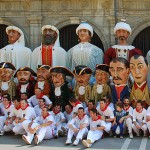The light-hearted fiesta of La Tomatina takes place on the last Wednesday in August every year in the Valencian town of  Buñol. Unlike many of Spain’s other celebrations, which are centuries old, La Tomatina is relatively new, originating around the end of World War II.
Buñol. Unlike many of Spain’s other celebrations, which are centuries old, La Tomatina is relatively new, originating around the end of World War II.
How it began is not entirely clear, but it seems that some sort of food fight broke out during a town celebration in 1944 or 1945. The young people apparently had so much fun that they decided to repeat the spectacle on the same Wednesday the following year, and despite several attempts to ban it during Franco’s rule for having no religious significance, it is now a firmly-established tradition. Today, thousands of people from all over the world flock to take part in the event, where they throw over-ripe tomatoes in the town’s streets.
The festival officially begins after one person scales the palo jabón, a greased pole with a ham on top. As if climbing a greasy pole wasn’t difficult enough, crowds are sprayed with water as the atmosphere builds. The successful climber wins the ham as their prize then a water cannon fires into the air and the tomato hurling officially begins. Trucks bringing over 100 tonnes of the fruit for revellers to throw at one another in an hour-long free-for-all until the second water cannon fires to signal the end.
During such a riotous event as La Tomatina, there may be more shrieking, screaming, yelling and, above all, laughter than any sort of conversation you may learn on a Spanish Language Course. You may not get the chance to expand your vocabulary much, but it’s a great spectacle and pure fun – well worth taking part in at least once.
 the UK as the running of the bulls – if you’re taking a
the UK as the running of the bulls – if you’re taking a  Las Fallas, which is celebrated in Valencia and means ‘the fires’ in the local dialect. Originally a celebration in honour of the feast day of St. Joseph, Las Fallas has today evolved into a 5-day event to which up to two million people flock from all over Spain and indeed the world.
Las Fallas, which is celebrated in Valencia and means ‘the fires’ in the local dialect. Originally a celebration in honour of the feast day of St. Joseph, Las Fallas has today evolved into a 5-day event to which up to two million people flock from all over Spain and indeed the world. and this is highly commendable as there is strong research to suggest that these students are more likely to stick with their studies and enjoy better results. Those with a sharp eye for all matters Spanish in the news will no doubt have read the news that King Juan Carlos is set to abdicate and hand the throne to his son, Crown Prince Felipe.
and this is highly commendable as there is strong research to suggest that these students are more likely to stick with their studies and enjoy better results. Those with a sharp eye for all matters Spanish in the news will no doubt have read the news that King Juan Carlos is set to abdicate and hand the throne to his son, Crown Prince Felipe. voices and accents and exposing yourself to new vocabulary can really bring your skills on in leaps and bounds. When you embark on a course of our
voices and accents and exposing yourself to new vocabulary can really bring your skills on in leaps and bounds. When you embark on a course of our

 appreciated, however, there are some Spanish phrases that you really should ditch and stick to what you learn in your
appreciated, however, there are some Spanish phrases that you really should ditch and stick to what you learn in your  are familiar with. Most of us have heard, for example, of Franglais – a combination of Français and Anglais – in which English words are adopted into French grammar, le weekend being an oft-quoted example.
are familiar with. Most of us have heard, for example, of Franglais – a combination of Français and Anglais – in which English words are adopted into French grammar, le weekend being an oft-quoted example. course
course